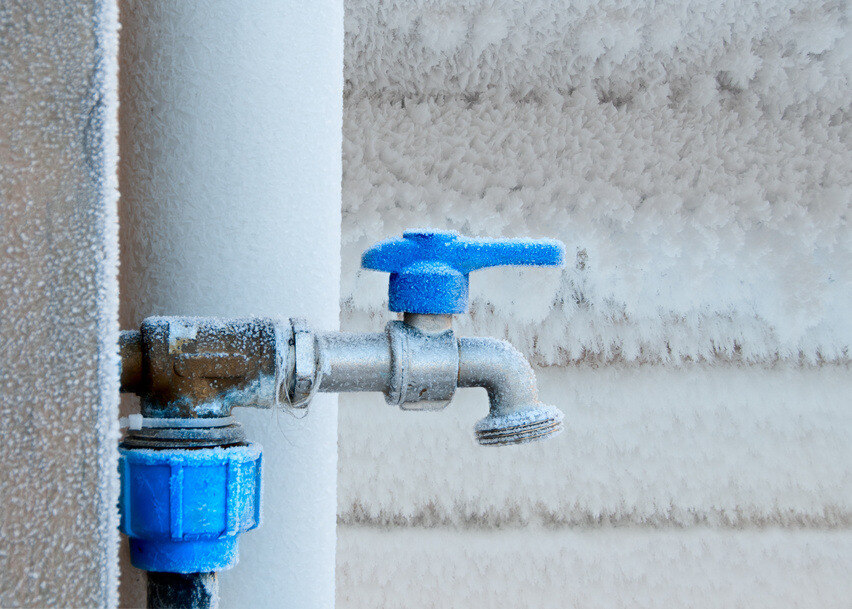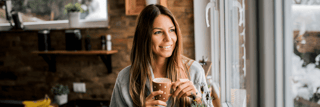How to prepare your home for winter (12 tips + winter preparedness checklist)
Complete this winter home maintenance checklist before the chill sets in.

Key tips to remember:
- Make sure your heating system and fireplace are ready to go.
- Prevent pipes from freezing.
- Prepare for a winter storm.
- Stay ahead of ice dams.
- Protect your floors and walkways.
- Replace batteries in smoke and carbon monoxide detectors.
- Inspect for drafts and seal air leaks.
- Swicth the director of your ceiling fans.
- Get your seasonal tools ready for winter.
- Perform a roof inspection.
- Prep your chimney.
- Winter proof your sprinkler system.
Are you excited for winter? We know the prospect of cozy nights by the fire, wearing your favorite jackets and coats, and enjoying your favorite winter sports can be exciting. However, one aspect of winter may be overwhelming for some homeowners. See, winter can demand considerable preparation to ensure that your home is ready for all that comes with the blistering temperatures and other seasonal changes. If you need help figuring out how to prepare your home for winter, we've got you covered. At Cinch Home Services, we are excited to guide you through a winter preparedness checklist for your home.
Like with any new season, winter can require a considerable amount of maintenance and repairs. But there's no need to panic. Simply tick down this winter home maintenance checklist — maybe even check it twice — and you'll be ready to relax and enjoy the season. Let's get started.
1. Make sure your heating system and fireplace are ready to go.
It's about to get chilly, so the last thing you need is an unexpected issue with your heating system. You can get the full lowdown with our furnace maintenance checklist. Still, it bears repeating that you should schedule a proper service appointment during which a professional can provide essential cleaning, care, and inspection — and do it now before you risk turning into a popsicle.
Homeowners with boiler systems should schedule a yearly cleaning and bleed the radiators, while gas systems should be cleaned every three years. An annual fireplace inspection and chimney sweep are also essential. Clogged chimneys are serious dangers that can cause house fires and carbon monoxide poisoning, so this is no area to skimp.
2. Prevent pipes from freezing.

The thing about water is that when it freezes, it expands, which can spell disaster for your plumbing. To prevent pipes from bursting, insulate pipes near windows, doors, and in areas of your home that don't get heated (check out our guide on insulating pipes here). These two tips will help protect your indoor plumbing:
- Keep your heat running and set it to no below 55 degrees Fahrenheit.
- Let water drip through faucets served by exposed pipes. When water moves, even at just a trickle, it's harder for the water to freeze.
Turn outdoor faucets and pipes off at the mains and ensure they are fully drained. You can also wrap them with insulating tape or foam for extra protection. It's helpful to paint your exterior faucet handles in a bright color in case you need to locate them quickly in the snow or at night if you need to shut and drain them in an emergency.
3. Prepare for a winter storm.
Do you know how to prepare your home for a winter storm?
Mother Nature can show off her nasty side during winter, which has a high potential for severe weather and power outages. Now is an excellent time to prep or replenish a snowstorm survival kit, complete with the following:
- First-aid supplies
- Flashlights
- Bottled water
- Nonperishable food
- Batteries
- Smartphone charger
- Hand-crank or battery-operated radio
Depending on where in the country you live and the severity of the winter weather in your area, you might also consider a generator or give it a test if you already have one. Follow our guide on installing a backup generator to expedite this process. This can prove to be clutch if a nasty power outage occurs.
Before the weather gets rough and home stores start selling out of equipment, you should also check the condition of your snow blower, shovels, gloves, and scrapers, and be sure to keep your snow supplies and roof rake near the door or where you have quick access to them. This is also a great time to get more organized and put that toolbox in storage filled with things you never use in winter.
Double-check that tree limbs are trimmed away from the windows and roof, and have a broom handy to brush away any snow that collects on them. This will help reduce the risk of a branch snapping under the weight of snow or ice. And remember: Always store fuel for your equipment in approved containers away from flame sources and never in the basement.
4. Stay ahead of ice dams.
Ice dams form when the roofline of your home is colder than the upper areas, which are usually parts of the attic with more insulation. Snow melts down from the higher, warmer roof collects in the colder eaves, forming a dam that prevents the melting snow from draining properly.
This can lead to severe roof damage. As with most home maintenance, it's all about prevention. Before winter weather sets in, make sure to:
- Clear debris from gutters, especially all those fall leaves that might have collected.
- Inspect and upgrade attic insulation so it's adequately distributed to keep the roof at an even temperature.
- Invest in a trusty roof rake to remove snow that collects after storms.
- You can also install heat cables along your roofline to help prevent ice damage.
For more roof maintenance tips, look at our easy-to-follow guide.
5. Protect your floors and walkways.
Knowing how to prepare your home for snow can be challenging. Snow and ice can become a real slip-and-fall hazard, not to mention deal a severe blow to your floors if constantly tracked through the house. For safety and to keep your flooring looking beautiful for years to come:
- Place mats both inside and outside each entrance to your home. • Have waterproof trays just inside the entryway to place wet shoes and boots.
- Provide a boot scraper or brush outside the door to remove excess snow.
- Have hooks ready inside for hanging wet coats and gloves.
This is also the time to make sure any steps leading to your doorway are free from tripping hazards and that you've got a sturdy handrail installed for when rain, ice, and sleet make things slippery. While you're at it, stock up on salt, ice melt, or sand before it's time to shovel the sidewalk and driveway.
Once you've taken these steps to prepare your home for all things winter, give yourself a short break. Maybe you can grab one of your favorite winter beverages or meals to provide some fuel for the rest of our guide on preparing your home for winter weather.
After a short intermission, let's keep going. Make sure you get through the rest of these steps to relax.
6. Replace batteries in smoke and carbon monoxide detectors.
A significant part of being prepared for winter is taking steps to keep you and your family safe. That's why ensuring that your smoke and carbon monoxide detectors are working correctly is vital. If you've been ignoring that annoying beeping sound that alerts you to change the battery in one of these devices, it's time to step up to the plate and get it done. According to the National Fire Protection Association (NFPA), some smoke alarms have batteries that must be changed at least once yearly. Why not do everything possible to be safe and increase your peace of mind?
7. Inspect for drafts and seal air leaks.
If you're hanging out at home and feel a sudden rush of cold air through a door or window, you might have an air leak. In addition to interrupting your comfort zone as you catch up on your favorite Hallmark movie, air leaks can prove costly and dangerous. Air leaks typically mean:
- Energy is being wasted, which slows down the operation of your HVAC and kills efficiency.
- An increase in your daily energy costs which will hurt your wallet and savings during a busy holiday season.
- Excess moisture in your home can lead to mold growth and adversely affect your health.
Here are some tips if you need help detecting air leaks in your home. According to Energy.gov, you should start with a visual inspection. Here is where you'll inspect all areas of the interior and exterior of your home to look for cracks and gaps. If you notice gaps around your home's windows or door frames, you can apply caulk to windows and doors for insulation. In fact, consumers can save 5-30% on their home energy bills by making home energy upgrades typically identified in a home energy assessment. Doesn't this sound like a possibility you'd like to explore?
Another potential avenue to save money is to check for leaks in your HVAC system. Before you do, make sure you have consulted a trained technician that can let you know how to check for leaks.
8. Switch the direction of ceiling fans.
If your ceiling fan has a reverse switch, run the fan's blades in a clockwise direction after you turn on your heat. Energy Star says the fan will produce an updraft and push down into the room heated air from the ceiling (remember, hot air rises). This is a great way to save energy (and money) on your bills! Just remember to adjust your thermostat as well.
Well, we did it! Once you've completed all these steps, your home will be in excellent shape to take on everything from quiet snow days at home to worrisome winter storms. If you're looking for even more peace of mind, ensure you have a home warranty plan* to protect the home you love.
* The product being offered is a service contract and is separate and distinct from any product or service warranty which may be provided by the home builder or manufacturer.
9. Get your seasonal tools ready for winter.
Before the weather gets rough and home stores start selling out of equipment, check the condition of your seasonal tools. Keep them near the door, organized in one section of your garage, or wherever you can access them. You should always have at least a small selection of essential tools like wrenches and screwdrivers, but when you're planning for cold weather and expect a solid dose of snow, be sure to include:
- Snowblowers
- Snow shovels
- Snow sweepers
- Ice scrapers
- Ice melters
- Roof rakes
10. Perform a roof inspection.
While you're at it, take a closer look at the roof. Replace any loose shingles, and remove any of those leaves or other built-up debris. You'll want to stay well ahead of those ice dams, which form when the roofline of your home is colder than the upper areas, usually parts of the attic where there's more insulation. Snow melting down from the higher, warmer roof collects in the colder eaves, forming a dam that prevents the melting snow from draining properly. This can lead to severe roof damage. As with most home maintenance, ice dam removal is all about prevention. Before winter weather sets in, make sure to:
- Clear debris from gutters, especially all those fall leaves.
- Inspect and upgrade attic insulation so that it's properly distributed.
- Invest in a trusty roof rake to remove snow that collects after storms.
- You can also install heat cables along your roofline to help prevent ice damage.
11. Prep your chimney.
When it comes to getting your chimney ready for the winter months, there are a few things that you may want to address. First, make sure no animals are trespassing. During the cold winter, animals such as raccoons love hiding in chimneys to stay safe and warm (can you blame them?). However, if an animal dies in your chimney, it can lead to a horrible smell and make it hard for you to exhaust smoke.
Next, examine the amount of snow and water entering your chimney. Once water gets in your chimney, it can cause water damage. That's why you may want to consider closing off your chimney to prevent these issues.
12. Winter proof your sprinkler system.
A sprinkler system is important because it saves time. While it often helps you maintain your yard, the system needs some care of its own to survive the winter months. Here are a few quick tips to winter-proof your sprinkler system.
- Check the user manual: Make sure you know how everything works that you've never used before
- Turn off the water: This is important to prevent water freezing. Spend some time draining water from the system as well.
- Shut off the timer: If your system works with an automatic timer, give it a break until spring rolls around.
- Insulate above-ground components: Any valves and pipes part of the sprinkler system should be protected from weather.
Once you complete our home maintenance checklist, there's one more thing that you may want to do. Take some time to check on your home warranty plan. Do you have home warranty protection? Is it about to expire, and you must ensure you renew it? Having home warranty protection may help you avoid unexpected expenses. The winter can be filled with broken HVAC systems, refrigerators, and other systems and appliances. Double-check your home warranty plan to ensure that you're ready for whatever winter throws your way.
The content on this Cinch article is for general information only. It is not intended to amount to specific advice on which you should rely. You must obtain professional or specialist advice before taking, or refraining from, any action on the basis of the content on this Cinch article.



